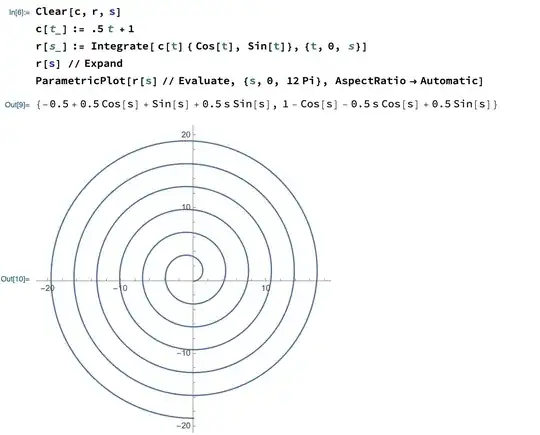This is similar to the problem of Calculating the length of the paper on a toilet paper roll.
In particular,
my answer to that question
assumes that the toilet paper is a material of uniform thickness (like your strap) that is rolled onto a cylinder so that each new layer of toilet paper is cylindrical.
I think that if the surface the paper/strap/cable is wound onto is initially cylindrical, this is a better model of the shape of the wound paper/strap/cable than any of the usual mathematical spirals.
There are some ways in which my toilet-paper answer does not perfectly match your question. I assumed we want to account for the transition from one cylindrical layer to the next; this transition occurs during the last few degrees of rotation before the start of the next cylindrical layer, and during that part of the rotation the paper/strap follows a non-cylindrical path (as it would have to in reality).
Unlike the earlier question I was answering, you want to use the total angle of rotation rather than the final radius of the spool as your independent variable.
Also, you are interested in the behavior in between full rotations.
One thing to consider is that as you wrap the strap/cable around the spool, either the outer surface will stretch or the inner surface will compress. Possibly both will happen. Presumably somewhere in the strap (at the inner surface, the outer surface, or some layer in between) the strap neither stretches nor compresses. If you want an accurate answer, you want to determine the layer within the strap where the length of that layer is preserved. In the toilet paper problem, as a simple guess I assumed this occurred exactly halfway between the inner and outer surface of the paper, but you could determine a more accurate estimate experimentally.
When you discover (or guess) which layer of the strap preserves its length, you use that layer as the cylinder that measures the length of strap rolled onto the spool.
If you simply assume that the strap is wrapped all the way around the spindle ($360$ degrees) in a complete cylindrical layer and then somehow starts a new layer offset by the thickness of the strap,
you can take the integer part of the total number of revolutions of the spindle and assume that the strap is wrapped in that many cylindrical layers around the spool, in addition to which there is a partial layer wrapped by rotating the spindle through the remaining fractional part of the total number of revolutions.
Since this problem involves lengths of circular arcs, I highly recommend converting your rotation angle to radians before proceeding.
Then if you rotate the spindle by $\theta$ radians,
the number of full revolutions is
$$\left\lfloor \frac{\theta}{2\pi} \right\rfloor$$
and the number of fractional revolutions is
$$\left\{\frac{\theta}{2\pi} \right\}
= \frac{\theta}{2\pi} - \left\lfloor \frac{\theta}{2\pi} \right\rfloor.$$
The total length of the complete cylindrical layers is a function of
$\left\lfloor \frac{\theta}{2\pi} \right\rfloor.$
The length of the partial layer is
$2\pi \left\{\frac{\theta}{2\pi} \right\} R,$
where $R$ is the of the cylinder to use for the last partial layer.
Let $r_1$ be the spindle/shaft radius,
$C_t$ the thickness of the strap/cable,
and $\delta$ the distance from the inner surface of each cylindrical wrap of the strap/cable to the place inside the strap/cable where the length is preserved ($\delta = 0$ if the inner surface does not change length,
$\delta = 1$ if the outer surface does not change length).
So the cylindrical surface representing the true length of the strap/cable during its first wrap around the spindle is $r_1 + \delta,$ and
the length of the first full wrap (assuming it goes a full $360$ degrees around) is $2\pi(r_1 + \delta).$
The length of the second full wrap is $2\pi(r_1 + \delta + C_t),$
the third full wrap is $2\pi(r_1 + \delta + 2C_t),$ and so forth.
For $n = \left\lfloor \frac{\theta}{2\pi} \right\rfloor$
full wraps we have length
$$ 2\pi(n(r_1 + \delta) + (1 + 2 + 3 + \cdots + (n-1)) C_t). $$
Using the formula for the sum of consecutive integers, this comes out to
$$ 2\pi\left(n(r_1 + \delta) + \frac{n(n-1)}{2} C_t\right). $$
The cylindrical radius to use when computing the length of the final partial layer is $r_1 + \delta + nC_t,$ leading to a length of
$$ 2\pi \left\{\frac{\theta}{2\pi} \right\} (r_1 + \delta + nC_t). $$
Putting it all together, and using the fact that
$n + \left\{\frac{\theta}{2\pi} \right\} = \frac{\theta}{2\pi},$ we have
\begin{align}
2\pi &\left(n(r_1 + \delta) + \frac{n(n-1)}{2} C_t\right)
+ 2\pi \left\{\frac{\theta}{2\pi} \right\} (r_1 + \delta + nC_t)\\
&= (r_1 + \delta)\theta
+ 2\pi C_t n\left(\frac{n-1}{2} + \left\{\frac{\theta}{2\pi}\right\}\right)\\
&= (r_1 + \delta)\theta
+ 2\pi C_t \left\lfloor \frac{\theta}{2\pi} \right\rfloor\left(\frac12
\left(\left\lfloor \frac{\theta}{2\pi} \right\rfloor-1\right)
+ \left(\frac{\theta}{2\pi}
- \left\lfloor \frac{\theta}{2\pi} \right\rfloor\right)\right) \\
&= (r_1 + \delta)\theta
+ 2\pi C_t \left\lfloor \frac{\theta}{2\pi} \right\rfloor
\left(\frac{\theta}{2\pi}
- \frac12\left\lfloor \frac{\theta}{2\pi} \right\rfloor
- \frac12\right).
\end{align}
 $c(t)=.5 t+1$ " />
$c(t)=.5 t+1$ " />